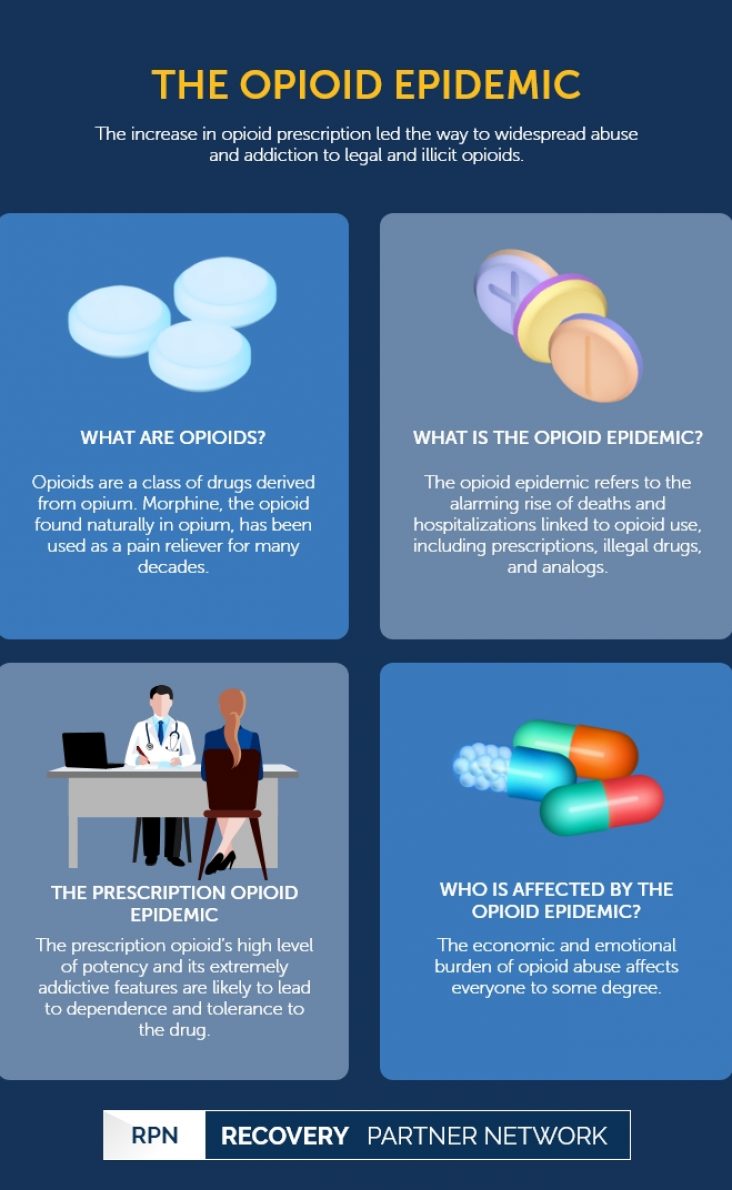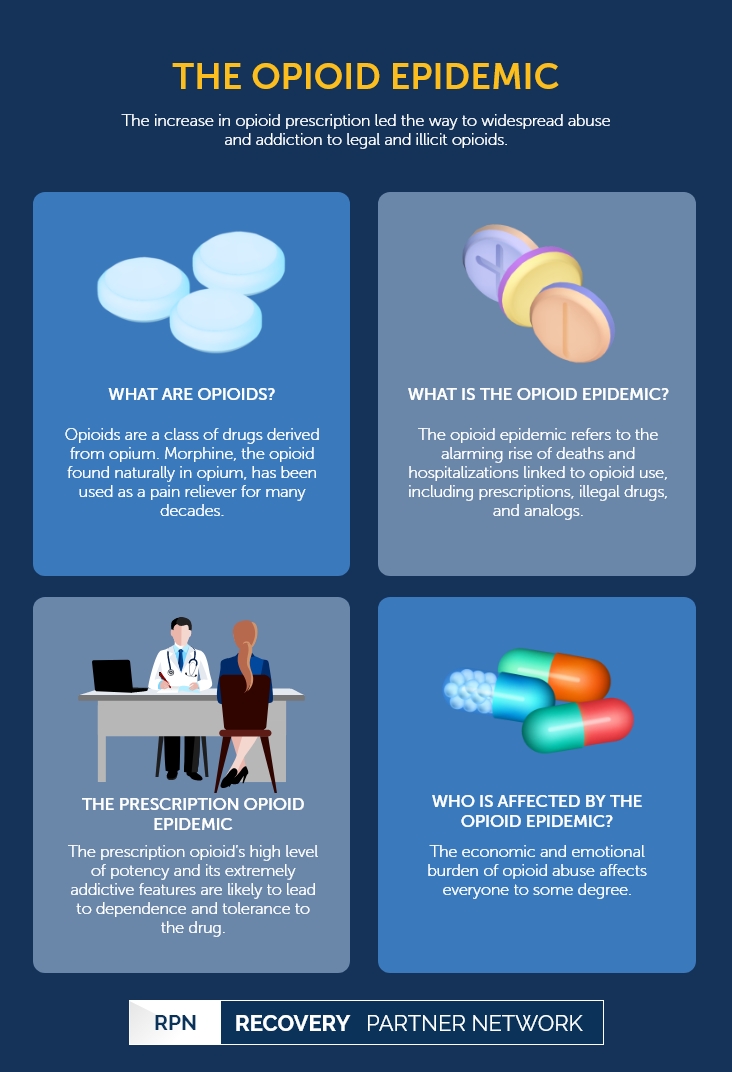The increase in opioid prescription led the way to widespread abuse and addiction to legal and illicit opioids.
The Opioid Epidemic
Opioid
- Hydrocodone/paracetamol addiction
- Buprenorphine/Naloxone addiction
- Central nervous system depressant
- Codeine addiction
- Dextropropoxyphene addiction
- Fentanyl abuse
- Hydromorphone addiction
- How Long do Opioids Stay in Your System?
- Hydrocodone addiction
- Kava addiction and abuse
- Loperamide addiction
- Lortab addiction
- Medical prescription opioid
- Methadone addiction
- Morphine addiction
- Norco addiction
- NyQuil addiction
- Opioid use disorder
- OTC substance abuse
- Oxycodone addiction
- Oxycodone/paracetamol addiction
- Opioid epidemic
- Lean addiction
- Pethidine addiction
- Snorting Oxycodone
- Synthetic Opioids
- Tramadol addiction
Opioid epidemic | Table of Contents
What are Opioids?
Opioids are a class of drugs derived from opium. Morphine, the opioid found naturally in opium, has been used as a pain reliever for many decades. Through the advancement of medical technology, experts have now discovered new ways to clone the effects of morphine into a diverse array of medications. As a result, opioids such as methadone were developed as a response to the scarcity of morphine, whereas others such as heroin were developed in an effort to make less-addictive drugs (although they would later become illegal to produce). At present, the use of opioids is almost always attributed to pain relief.
Examples of opioids include:
- Demerol
- Fentanyl
- Heroin
- Hydrocodone
- Dilaudid
- Methadone
- Oxycodone
- Tramadol
- Morphine
- Codeine
FAQ
Heroin and synthetic opioids such as fentanyl fall under the illegal opioid category.
The crisis situation presented by too many people misusing opioid drugs is often referred to as the opioid epidemic.
What is the Opioid Epidemic?
Also known as the opioid crisis, the opioid epidemic is the current hot button issue in the media. It refers to the alarming rise of deaths and hospitalizations linked to opioid use, including prescriptions, illegal drugs, and analogs. Opioid-related deaths in the US have skyrocketed to over 40,000 a year or 115 a day, according to recent surveys. Due to the opioid epidemic, drug overdose has also turned into the leading cause of accidental death in the US. Although the opioid crisis first caught the attention of the public in 2010, the contributing factors to its surge started many years earlier.
FAQ
- How do you address an opioid crisis?
- How does the opioid epidemic affect families?
- What are the consequences of an opioid epidemic?
- Who is most impacted by the opioid epidemic?
Encourage more providers to treat substance use disorder (SUD), reduce the obstacles in the administration process associated with treating patients with SUD, support, and promote research in preventing and treating opioid use disorder.
Opioid addiction can have devastating effects on families. It could lead to a breach of relationships and broken family bonds. This happens mostly due to the addicted individuals lying, stealing, or becoming abusive towards family members.
Increasing numbers of addiction and overdose, as well as many infants born experiencing withdrawal symptoms due to their mothers using opioids during pregnancy, are some of the devastating consequences of the opioid crisis.
The people that are highly impacted by the opioid overdose epidemic are young adults between the ages of 25 to 34, older adults between the ages of 45 to 54 years, veterans, and native Americans.
How Did the Opioid Epidemic Start?
The crisis is believed to have started in the late 1960s when pharmaceutical companies started promoting synthetic and semi-synthetic opioids to doctors as a response to the growing demand for new painkillers. These companies claimed that the drugs were either less- or non-addictive in comparison to morphine, with no fatal side effects. Gradually the doctors began to accept the drugs as patients who consumed them showed no visible repercussions. This led to the dramatic growth of prescription opioids, contributing to the epidemic that is currently affecting thousands of individuals worldwide.
- Opioid-related deaths in the US have steadily increased over time, with an average of 115 fatalities a day since 2014.
- Eighty percent of individuals with a heroin addiction started with a prescription for an opioid pain reliever.
- The cost of prescription opioid abuse in the US is about $78.5 billion per year.
The Prescription Opioid Epidemic
Most individuals who form an addiction to opioids begin with a doctor’s prescription. Patients who are prescribed opioids by their doctors are generally under the misconception that it is safe due to its prescriptive nature. However, with the high levels of potency and its extremely addictive features, patients are inadvertently exposed to the risks of dependence and tolerance to the drug. The rapid build-up of tolerance and dependence caused by opioid consumption leads most patients to experience withdrawal symptoms when trying to quit. This causes patients to continue using the drug to avoid experiencing withdrawals and function as normal on a daily basis. This is often the stage where individuals turn to illicit drugs or analogs such as heroin as it is cheaper, more potent, and easily accessible than prescription opioids. As a matter of fact, about 80 percent of individuals with heroin addiction started off their drug dependence with a prescription for opioids.
How the Opioid Epidemic Differs from Other Drug Problems
The number of deaths related to accidental opioid overdose overshadows all other drugs combined. Of the 52,404 deaths from a drug overdose that occurred throughout the US in 2015, more than 20,000 were related to prescription painkillers, and close to 13,000 were from heroin. This indicates that around 63 percent of drug deaths were linked to opioids. This number of opioid-related deaths rose alarmingly by nearly 10,000 the following year. However, the most daunting part of the whole scenario is the number of deaths associated with prescriptions provided by a doctor for a legitimate medical condition.
- Before the massive push for opioids by pharmaceutical firms, physicians wrote 112 prescriptions for opioids in 1992.
- The number of opioid prescriptions rose to 236 million in 2016, after a peak of 282 million in 2014.
Who is Affected by the Opioid Epidemic?
The opioid crisis affects individuals of all demographics and walks of life, including teens, adults, veterans, and the LGBTQ community. Even the ones who do not use or abuse opioids may feel the effects of opioid abuse if it is widespread within the community or if a member of the family is grappling with it. The economic and emotional burden of opioid abuse affects everyone to some degree, and as such, everyone must take effective and collective steps to tackle the crisis. Understanding the dangers, signs, and symptoms of opioid abuse and talking freely with one’s family, friends, and community to remove the stigma of addiction can greatly contribute to weakening and eventually overcoming this crisis.
Recovery Partner Network
We aim to educate and empower. If you feel our library of resources does not cover your specific need, reach out to us, and we would be happy to help.
STATISTICS
© Copyright 2026


